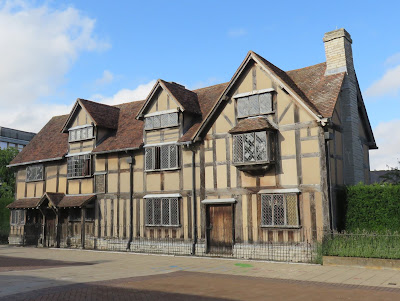(If, like me, you are unfamiliar with the plot, skip to the end of the post for a synopsis).
It was interesting to see it so soon after having seen 'A Midsummer Night's Dream' as, like that play, it features Theseus and Hippolyta, just before their wedding (although here they are interrupted by a small war!)
I think the costume designers had fun with this production - Duke Theseus (Gyuri Sarossy) shows up for his wedding in a glorious, gold-frogged military greatcoat over a Greek-themed shirt, he goes hunting and maying in blinged-up motorcycle leathers, with 3D skulls on the shoulders!
He's also surprisingly wiling to put of his wedding in order to go fight a battle, and seemed clsoer to, and more attracted by, his (admittedly extremely attractive) friend Pirithous than to his bride!
Hippolyta (Allison McKenzie) has a gold helmet and tribal tattoos, and looks every inch the warrior queen.(She also, at one point, had an entirely unexplained chainsaw, which I suspect may not have been mentioned in Shakespeare's original script and stage directions)
 |
| Palamon and Arcite (Photo from RSC website) |
I really enjoyed the production - there was a very strong cast, the plot (through preposterous) moves swiftly and there is a lot of humour, despite the somewhat bloody plot. It's a play about love, as much as anything. Arcite and Polamon are at all times, even when fighting one another, very close, and poor Emilia, the cause of their discord, is herself unenthusiastic about either of them and describes her far closer, and deeper feelings for a female friend.
The Jailer's Daughter (Danusia Samal) who is, Ophelia-like, driven mad by unrequited love, is a fascinating character - vulnerable and yet, of all the characters, genuinely loved. Her father, uncle and suitor all working together to try to heal her, and despite her not being named, is one of the more rounded characters.
Well worth seeing.
Plot Summary
For those who, like me, are unfamiliar with the play, the plot is fairly straightforward.
Theseus, Duke of Athens, is about to marry his Amazonian bride, Hippolyta, then the celebrations are interrupted by the arrival of three widowed queens, who beg him to drop whatever he is doing, and rush to Thebes to fight the tyrant Creon and allow them to find and bury their husbands, slain in battle and denied proper rites. Theseus agrees, after some persuasion, to put off his wedding and go to fight instead. Meanwhile, noble cousins Palamon and Arcite discuss leaving Thebes in disgust at the corruption there, but when they hear Theseus is attacking, they decide to fight for their city, if not for their Duke.
Theseus is, naturally, victorious, and Palamon and Arcite are taken prisoner. While imprisoned, they see Hippolyta's sister, Emilia, and both fall instantly in love with her, and fall out with each other. Arcite is then released by Theseus, on condition her leaves the country, but chooses to remain, in disguise, in the hopes of wooing Emilia. He is successful in the midsummer games and Theseus (who totally fails to recognise him) gives him a post as servant to Emilia. Meanwhile, Palamon remains imprisoned. His jailer's daughter falls in love with him and releases him, hoping he will love her back (He doesn't, so she goes mad, gets caught up with some Morris Dancing (which probably doesn't help) and then, on the advice of a Doctor called in by her father) is cured by her former suitor posing as Palamon.
Arcite finds Palamon in the forest, brings him supplies and feeds him up until he is fit enough to fight to the death over Emilia. They are discovered by Theseus, who admires their manliness, so rather than executing them sends them home to prepare, prior to a duel to the death involving their closest friends as well as themselves, with the winner to marry Emilia and the loser to be executed. Their friends are surprisingly ready to agree to this.
"So mate, will you come and fight for me? If we lose, we all get executed. If we win, I get to marry the girl"
"Sure, why not Sounds fun"
Both pray to the gods and receive encouragement from them, and prepare to fight.
Arcite wins the duel, but is then stumbled to death by a horse, and has a tearful-but-manly farewell scene with Palamon, to whom he bequeaths his bride-to-be, so that Palamon (and his friends) are not, after all, executed.
Emilia, you notice, has no say in any of this, but ends up with a *very* manly and only slightly battered husband, so is presumed to be happy.
The play is on in Stratford until 7th February 2017, so you've plenty of time to see it!











